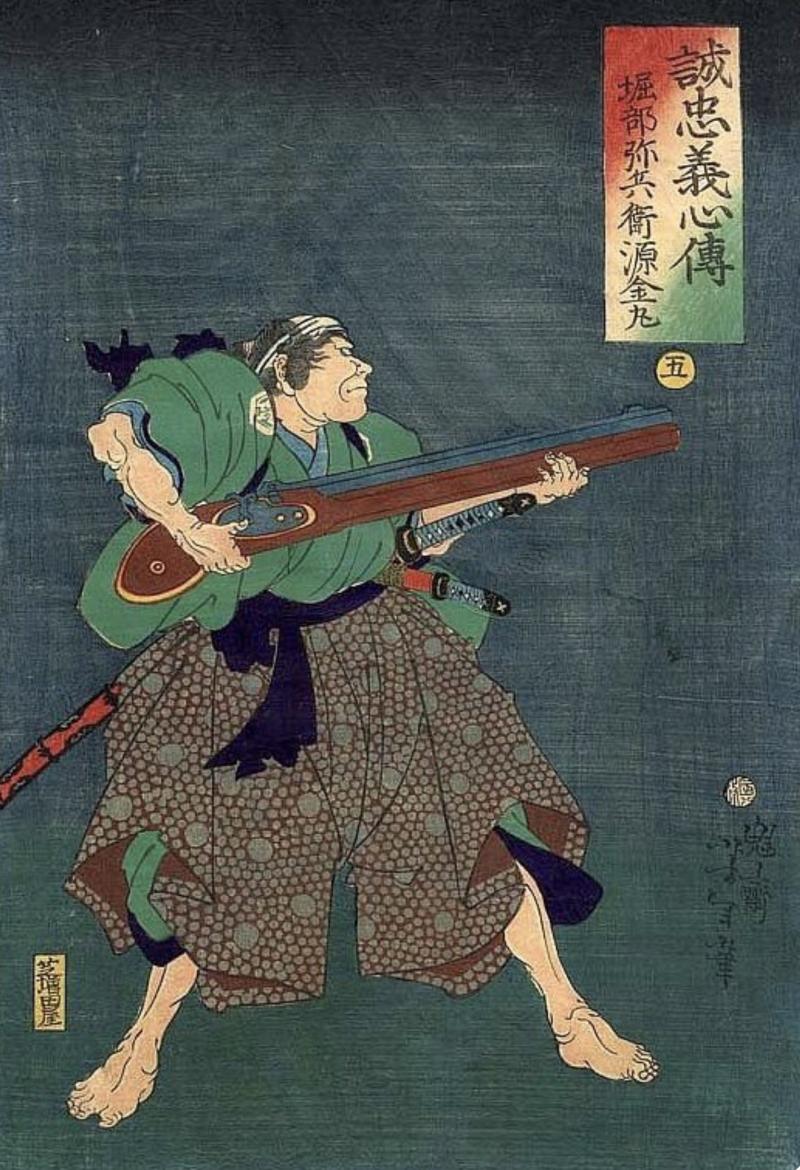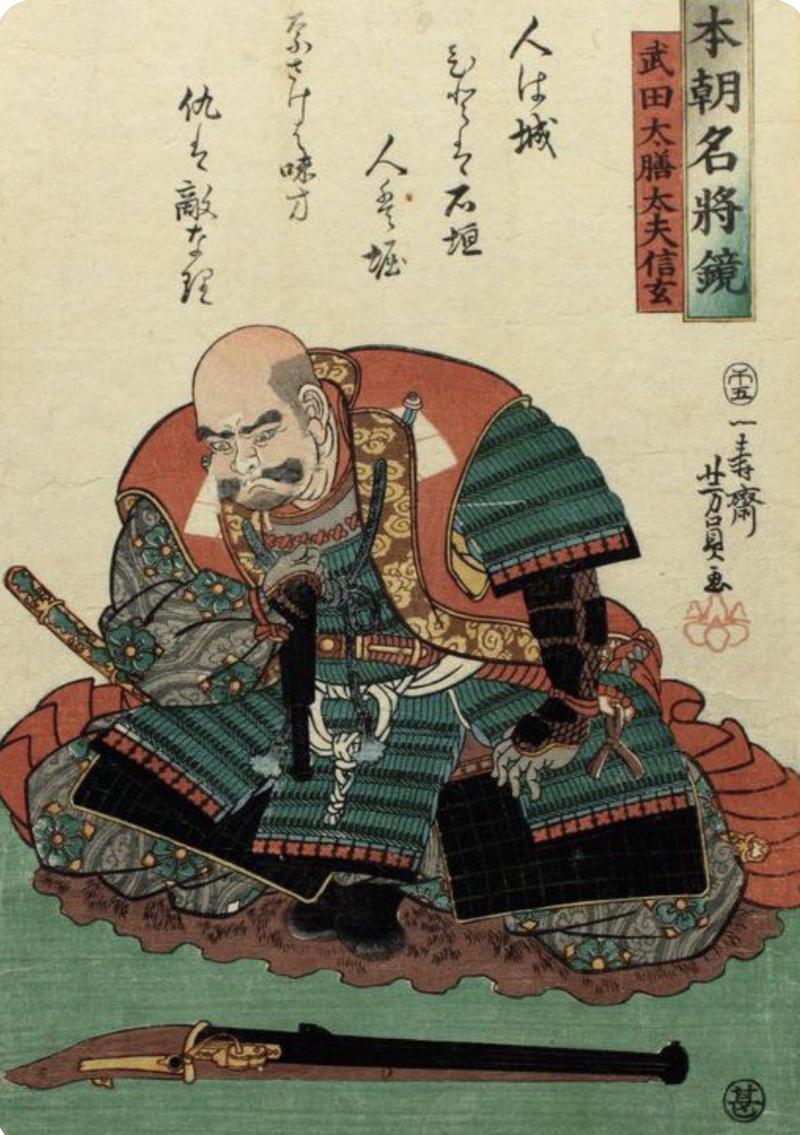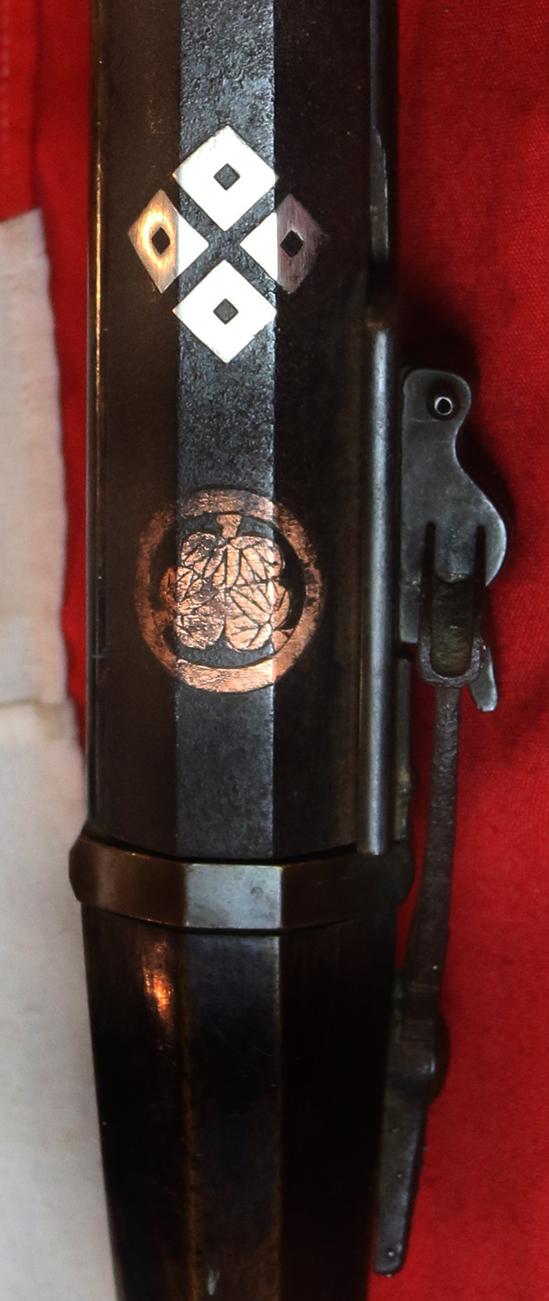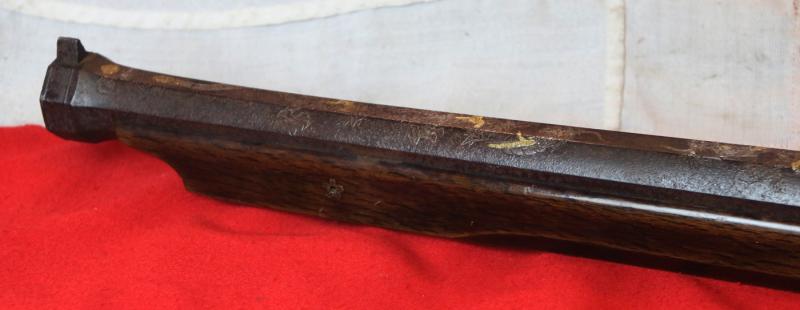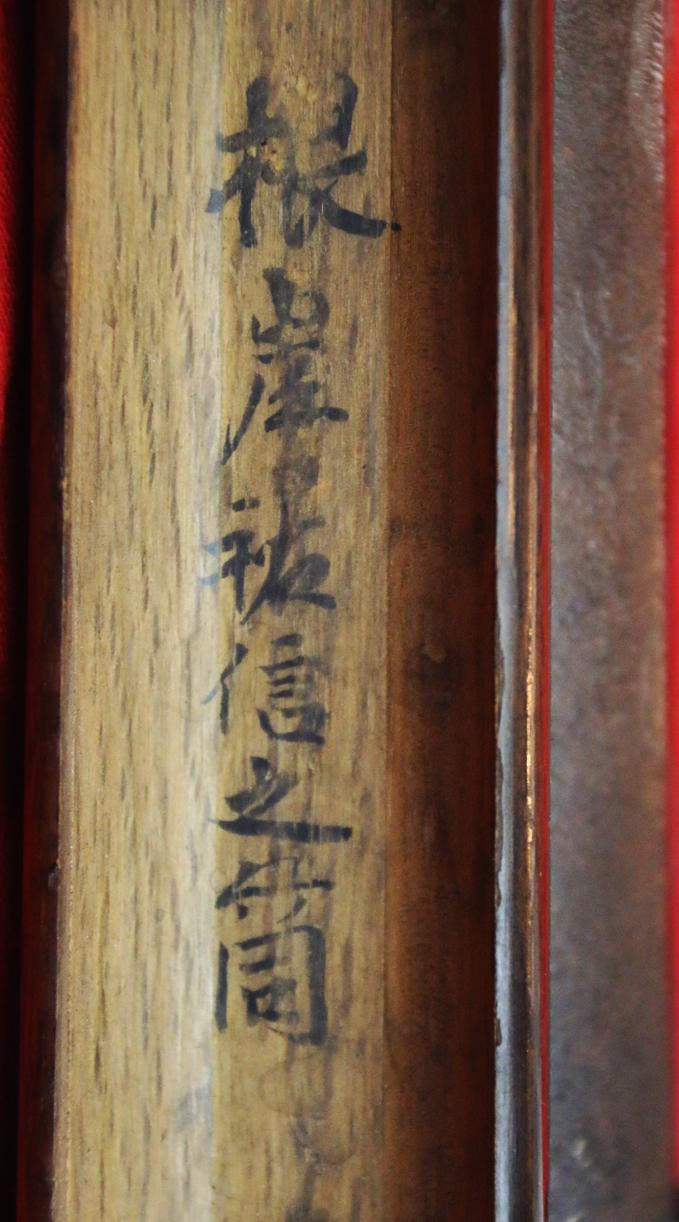A Simply Magnificent, Huge, Ozutso Samurai Hand Cannon Teppo Matchlock Gun, of Negishi Sukenobu, Inlaid With Silver and Gold Dragon With Both the Amago Clan of Kamei Kenenori and Tokugawa Clan Mons.
Signed Japanese red oak stock. The huge uncompromising barrel is inlaid with twin, large silver Amago clan mon and and gold-copper triple leaf Aoi, clan mon of the Tokugawa at the breech, it has a pinhole block site, extravagant gold and silver scrolling dragon inlay, up through the length of the barrel, terminating in a multi sided and stunning tulip form muzzle. Within the channel of the stock is a beautiful hand scripted signature of the samurai owner, Negishi Sukenobu no Tutu. Translation; Negishi Sukenobu's gun tutu is an old Japanese name for a matchlock gun
It has a sinchu matchlock mechanism with a long engraved match arm, inlaid with speckles of silver, traditional spring release utilising the ball trigger. the stock has engraved, silver cherry blossom form inlaid, barrel retaining mekugi-ana apertures, for the long copper mekugi to retain the barrel..
Part of a huge collection that just arrived after a long and patient wait a sensational O-Zutsu hand cannon tanegashima, it is huge and incredibly heavy, of around 10 monme, 18mm bore
It is often the case were early samurai weaponry bear twin mon decoration, often demonstrating a co-joining or allegiance between two samurai clans.
Resembling the Portuguese arquebus, the first matchlock gun to be seen in Japan, this massive and handsome weapon expresses the Japanese desire for powerful, finely made firearms.
A 17th century Japanese tradition relates that after the accidental arrival of three Portuguese mariners on Tanegashima Island in 1543, the sword-smith Kiyosada gave his daughter to their captain in order to learn the secrets of musket manufacture.
The actual guns were snap matchlocks made in Malacca, a Portuguese colony, and by 1550 were in production on a large scale. Known as ‘Tanegashima’ or ‘Teppō’ they were used by the Samurai and their foot soldiers and changed the way war was fought in Japan forever.
Large carbines such as this example were known as ‘ozutsu’ or cannon and were mounted on castle walls, used on merchant ships to repel pirates, on horseback in war or as assault weapons to blast through door hinges.
They could also launch incendiary or explosive arrows known as ‘Hiya’ to set fires during sieges. When fired these powerful weapons had a large recoil, and bales of rice were used to support the gunners back from injury.
Ammunition consisted of heavy round lead balls with differing sizes described as ‘Monme’. Made to take between 10 to 30 ‘Monme’ shots, this carbine is one of the largest examples of Japanese Edo Period handheld firearm
One woodblock in the gallery of a samurai holding an ozutso, and another of the great Takeda Shingen contemplating a small teppo matchlock gun, and it’s dramatic effect on the future of samurai warfare. The shape and form of ours is the same as the one contemplated by Takeda Shingen in the print, but ours is around four times the size, not a long gun but of incredible mass, beauty and presence. Somewhat like a dragon, a beast to admire for its breathtaking beauty, but to fear and respect for its power and presence.
The Amago clan, descended from the Emperor Uda (868–897) by the Kyogoku clan, descending from the Sasaki clan (Uda Genji).
Kyogoku Takahisa in the 14th century, lived in Amako-go (Omi Province), and took the name 'Amago'. The family crest, is also the one of the Kyogoku clan.
They were Shugodai (vice-Governors) of Izumo and Oki provinces for generations, for the Kyogoku Shugo branch , and their seat was Gassan Toda castle.
In 1484, Amago Tsunehisa (1458–1541), was deprived of the position of Shugodai by Kyogoku Masatsune, who was the Shugo, because he did not obey the request of tax from the Muromachi bakufu, and was expelled from Gassan Toda castle. Although Enya Kamonnosuke was dispatched to Gassan Toda castle as the new Shugodai, Tsunehisa recaptured Gassan Toda castle by a surprise attack in 1486, took control of Izumo, and developed the Amago clan into a Sengoku Daimyo clan.
The Amago fought the Ouchi clan or the Mori clan (who had been among their vassals), during Japan's Sengoku period.
For much of the next hundred years, the clan battled with the Ouchi and Mori, who controlled neighbouring provinces, and fell into decline when Gassantoda Castle fell to the Mori in 1566.
Amago Katsuhisa tried to regain prestige for the clan by joining the forces of Oda Nobunaga, invaded Tajima and Inaba provinces, but was defeated and died in the siege of Kozuki by the Mori in 1578.
Kamei Korenori (亀井 茲矩, 1557 – February 27, 1612) was a Japanese daimyō who lived through the early Edo period. He was first a retainer under the Amago clan of Izumo Province, but eventually became a daimyō in his own right. Receiving Shikano castle in Inaba Province as a reward for his notable service in 1578, Korenori ascended to higher rank as he assisted in Hideyoshi's 1587 invasion of Kyūshū. Following Hideyoshi's death in 1598, entered the service of Tokugawa Ieyasu. Following the Sekigahara Campaign of 1600, his income was raised from 13,000 to 43,000 koku as a reward for his service to the Tokugawa clan. Korenori died of natural causes in 1612.
Korenori's descendants were eventually made daimyō (lords) of the Tsuwano Domain, which they ruled until the Meiji Resoration.
Weight an impressive and formidable 6.6 kilos, length overall, 42 inches, barrel 30.5 inches
Code: 24307
9750.00 GBP

